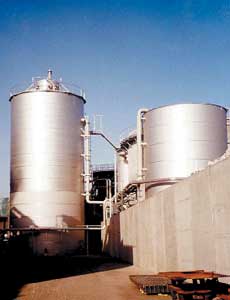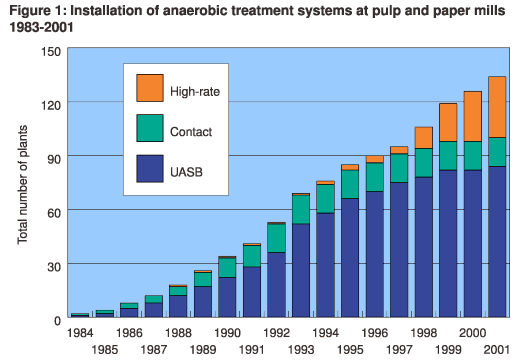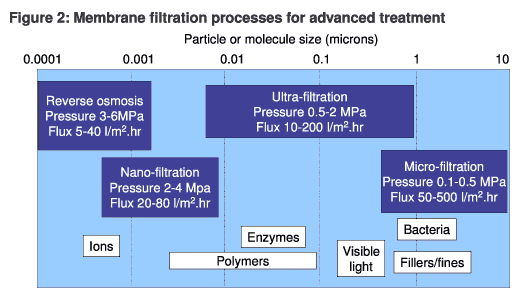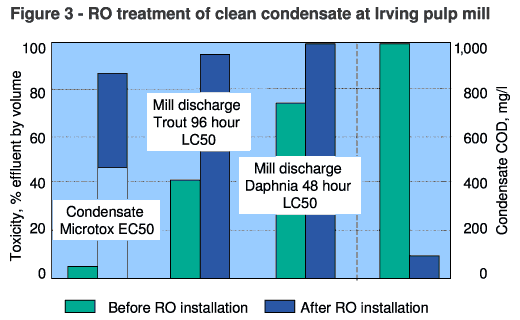Kidney technology brings success
by Leslie Webb
An EU-funded program on "kidney technology" is looking at maximizing the use of integrated treatment processes to remove unwanted or undesirable materials from papermaking. But are the targets realistic?
 |

Paques' IC reactor operates at VPK Oudegem mill |
Legislation has always been the strongest driver for improvements in the quality of effluent discharges and, at least within the countries of the European Union (EU), much of this will now come about through implementation of the directive on integrated pollution prevention and control (IPPC). As mentioned in last year's article (PPI, April 2001), the UK was the first country to begin IPPC implementation and the paper industry was the first sector to be immersed in this new regime. One year later, all affected mills will have filed their applications, most will have finished answering any subsidiary questions and some (just how many is difficult to say at the time of writing) will have actually received their permits to operate. In addition to emission limits, an important element within the permit is an improvement program, where shortcomings have to be rectified, usually within a set timescale. Judging from results so far, optimizing water management will be a constant feature within these programs even where mills are already at the lower end of the best available technology (BAT) scale for specific fresh water consumption.
Bio-kidneys
Manufacturers have continued to install high-rate versions of the anaerobic biological treatment process. Data published by the Dutch supplier, Paques, indicate some slowing down in the mid-1990s before a surge in the last few years as high-rate systems began to take over from UASB (upflow anaerobic sludge blanket) reactors (Figure 1). Nearly 80% of the installations have been in Europe. Germany has the greatest number (about 35) with the vast majority of all plants installed at recycled packaging mills. The most popular high-rate variant has been Paques' IC (internal circulation) reactor, which is now being operated at thermophilic temperatures of 50-55°C as well as in the more normal mesophilic range of 30-35°C.
 |
The best example of this application is the well-publicized plant at VPK's Oudegem mill in Belgium, where a great deal of research has been carried out as part of an EU-funded program on so-called "kidney technology". This terminology was first employed in the 1970s for the use of integrated treatment processes to remove unwanted or undesirable materials from papermaking circuits (the objective at the VPK mill) to maximize the degree of water closure, while meeting the discharge requirements. The pilot stage of this work included a membrane treatment step after the anaerobic/aerobic treatment system. Despite showing quite good results (30-45% chemical oxygen demand or COD removal), this has not been installed on a full-scale, at least so far.
The full-scale anaerobic/aeration stage is used to remove problematic substances in the main papermaking circuits, notably dissolved organics in relation to microbiologi cal problems plus interference with additives and dissolved calcium in relation to precipitation and again interference with additives. The circulation of about 400 m3/hr (9 m3/tonne of paper) of process water through the treatment system has stabilized the chemistry of the circuit waters at much lower levels than before the treatment installation (Table 1).
Table 1: Circuit concentrations at VPK Oudegem before and after installation of anaerobic / aerobic treatment
|
| Parameter (mg/l) |
Before treatment |
After treatment |
% change |
|
| BOD |
4,500 |
1,700 |
-62 |
| COD |
7,500 |
3,500 |
-54 |
| Calcium |
1,100 |
450 |
-59 |
| Sulfate |
350 |
200 |
-43 |
|
The mill is still not fully closed, but discharges about 4 m3/tonne from its pre-existing end-of-pipe anaerobic (older UASB type) plus aerobic treatment plant.
The work at Germany's PTS has also developed some useful "rules" about the removal of calcium in the aeration stage of what is normally a conventional activated sludge post-anaerobic treatment. The aerobic plant does several jobs in polishing the anaerobically-treated wastewater before discharge or recycling, including removal of residual biological oxygen demand (BOD), oxidation of residual sulfide to sulfate and precipitation of calcium as the carbonate.
At the VPK Oudegem mill, this second stage is purely aeration so there will be no BOD removal, the main purpose being calcium removal. The effect is only necessary because calcium carbonate from the recovered paper has dissolved within the papermaking process as a result of acidic conditions being allowed to develop in parts of the machine system. This is often due to microbiological action, which should itself be lessened through the substantial BOD removal occurring during bio-treatment. Nevertheless, calcium levels can still exceed 1,000 mg/l, so any process that can remove all or part of this before water recycling is useful. The various chemical equilibria that govern calcium dissolution and precipitation are well understood and aeration removes calcium from solution simply by removing the carbon dioxide (generated largely during the anaerobic stage) and allowing the pH to rise.
Table 2: Circuit concentrations at Kappa Zulpich before and after installation of anaerobic / aerobic treatment
|
| Parameter |
Circuit water
before installation |
Treated wastewater |
Circuit water
after installation |
|
| BOD |
20,000 |
50 |
5,000 |
| COD |
34,000 |
800 |
8,500 |
| Organic acids* |
12,000 |
<20 |
3,000 |
* Organic acids are teh sum of acetic, propionic, butyric and lactic acids |
|
Of course, the pre-installation concentrations are much lower than the concentrations would be at a similar mill, except for one with a zero effluent discharge (ZED) water system. The Kappa mill at Zulpich in Germany was one of the first mills to install an integrated anaerobic/ aerobic system within an existing closed water system. The treatment plant (in this case, UASB followed by activated sludge) simply processed about 4 m3 of process water/tonne of paper before returning it to the mill system. The circuit concentrations stabilized at much higher levels than at the VPK mill, but were low enough to obviate the previous difficulties caused by the presence of very high concentrations of organic acids. After integrated treatment, the product no longer had an unattractive odor due to the lower level of retained organic acids, which declined from around 1.5% to about 0.2% of the paper weight. Similarly, the air quality around the mill and in the nearby town improved considerably due to the 95% reduction in the emission of volatile organic compounds (VOC) in the exhaust air from the paper machine building.
Two of the questions in installing an integrated treatment plant are: where is the optimum location to extract the process water for treatment and how much process water should be routed through the plant?
In the two examples given, the answer has been simply to use the machine backwater, from which any useful fiber can be removed and returned separately before biotreatment. However, the quantity of process water treated is quite different, 9 m3/tonne at Oudegem and 4 m3/tonne at Zulpich. It can be shown by simple steady-state modeling that, provided the plant is designed for hydraulic loading and at a constant removal efficiency, the amount of BOD/COD removed increases with flow, but the improvement is quite small above a flow of about 10 m3/tonne.
Another option is to extract the process water much earlier in the system, preferably at a suitable stage during stock preparation through the use of a stock thickener. Modeling of this option clearly shows that treatment of the thickener filtrate instead of the backwater lowers the circuit concentrations significantly at the same hydraulic flow through the treatment plant (Table 3). The concentrations of dissolved organics are reduced to levels rarely seen on machines with quite open water systems. This has great potential benefits in terms of lower process control costs and better runnability, not to mention minimized risks of poor product quality.
Table 3: Effect of stock thickening and treated flows on circuit COD concentrations in a fully-closed water system
|
| Treated flow |
Thickened stock |
Circuit concentrations (g/l) * |
| (m3/tonne) |
consistency (%) |
Without thickener |
With thickener |
|
| 11 |
5 |
5.1 |
3.6 |
| 21 |
10 |
2.9 |
1.3 |
| 26 |
20 |
2.4 |
0.7 |
| 29 |
50 |
2.1 |
0.5 |
* Based on 50 kg dissolved COD/tonne of paper and constant 80% COD removal during treatment |
|
Straining for success
The technique of filtration is well known to the paper industry as it is at the heart of how paper is formed and it is also widely used for treating water and recovering fiber within backwater and effluent systems. The latter is only necessary because the formation fabrics are relatively coarse and are not intended to retain the finer particulate solids. Of course, this is technically possible, but would be economically disastrous due to the very slow drainage rates. The issue of drainage rate or hydraulic flux/loading (flow per unit are per unit time, typically in units of l/m2.hr) is very important for all water/wastewater treatment filters, but particularly so for the membrane filters that are capable of removing various fractions of the dissolved solids.
The driving force for separation by membranes can be by electrical potential (as in electrodialysis) or by a concentration gradient (as in ordinary dialysis), but the most common is through the application of pressure. The family of pressure-driven membrane techniques is now well-known with the application pressure increasing from micro-filtration (MF) through to reverse osmosis (RO, sometimes called hyper-filtration) as the membrane gets finer and able to remove smaller and smaller substances (Figure 2). The flux increases with applied pressure, but so does the energy consumption which is 1-10 kWh/m3 of permeate depending on membrane type and efficiency. Optimizing the membrane structure itself brings together a multiplicity of often inter-dependent variables, for example:
• the membrane material, which can be ceramic, metallic or polymeric with the latter being the most common on cost grounds,
• the membrane configuration, which can be formed from flat sheets into spiral-wound or plate/frame units and from hollow fibers or coated tubes,
• the modus operandi in terms of either "dead-end" operation (as in conventional filters where the concentrate such as a sludge accumulates on the filter medium until it is removed by, for example, some form of doctoring device) or cross-flow operation, where the input stream passes across the filter surface and a proportion returns to the inlet for further concentration or proceeds to a second membrane for more treatment.
 |
Although a few membrane plants were installed at pulp/paper mills in the 1970s and 1980s, the early 1990s saw a surge of new installations, notably for the recovery of coating components from coating wastewaters. There are now numerous ultra filtration (UF) membrane installations from various suppliers doing the job. Outside this area, membranes have been used both within the mill for water recovery and as part of external treatment plants to improve wastewater quality for discharge or re-use. In the latter case, membranes are being used not only as a treatment stage in their own right, but as the separation step in one of the newest versions of the activated sludge process, the membrane bioreactor (MBR) process (PPI, April 2000).
The most extensive membrane installation is probably at M-real's Kirkniemi mill in Finland, where there are 19 UF membrane units at five different locations (including coating) across all three paper machines and one nano-filtration (NF) unit. All the membranes are supplied by Metso PaperChem (formerly Valmet-Raisio) and all the UF membranes are the CR design, which employs a rotor above each membrane to minimize build-up and maintain a high flux. Over five years of operation, UF membrane life has averaged 1.5 years with a cleaning regime of alkaline washing every five days. The spiral-wound NF membrane is used to treat the UF permeate on one machine and lowers the dissolved COD and conductivity by about 80%, allowing this water to be used as fresh water. Weekly acid cleaning is needed to maintain the NF membrane in optimum working condition. The use of membranes has contributed to this mill achieving, what is for its type, the very low fresh water consumption of about 6 m3/tonne.
One of the latest installations of Metso's CR UF membrane is at the greenfield Propapier recycled liner/fluting mill in Germany, where the UF system treats clear disc filtrate for use on wire showers. A similar type of mill in the US, but one with ZED, is also using UF to provide water for showers and pump sealing. As described in PPI, April 1999, another ZED recycled mill in the US, McKinley Paper in New Mexico, is using two membrane processes (MF and RO) in series as part of its external water recovery system.
A rather different application of an RO membrane is Irving Pulp and Paper's mill in New Brunswick, Canada. This bleached kraft mill produces 280,000 tonnes/yr of market pulp. The mill is unusual in that it chose to meet the legislative requirements on the effluent discharge by in-plant measures as it has no biological wastewater treatment plant. These measures included two-stage brown stock washing, closed screening and oxygen delignification, which together lowered the BOD discharge by 60%.
Although the wastewater toxicity was also significantly improved by these measures, about 60% of samples still proved acutely toxic to trout and some endocrine disruption to a local fish species was also evident. Previous work improved effluent quality by improved steam stripping of foul condensates, but the mill identified the clean evaporator condensate as contributing significantly to effluent BOD and toxicity. An RO plant was installed in 1998 to treat around 6,000 m3/day of the condensate from the 5th effect evaporation stage, the permeate being recycled to the post-oxygen stage washer and from there into the whole mill wastewater. The effects on the condensate stream's COD and Microtox EC50 (the level that reduces light emission by 50%) and on the whole mill effluent's trout and daphnia LC50 (the level that kills half of the test species in the stated time) is shown in Figure 3. In addition to reducing about 90% of the condensate's dissolved organics, the acute toxicity in the effluent discharge is virtually eliminated and steroid hormone levels in another fish species were allowed to recover to more normal levels.
Powerful treatments
The use of ozone to enhance COD removal by biological treatment has been employed on a full-scale for a couple of years, but an ozonation plant for color removal has now been installed at a small German mill. This is Büttenpapierfabrik Gmund, which produces about 5,000 tonnes/yr of colored papers on two machines. The wastewater from the mill used to be treated simply by physico-chemical processes before discharge into the local sewage treatment works. The new treatment system extends the existing flotation plant with a fine filtration stage before ozonation in an air-based 3 kg/hr of ozone plant from Wedeco. The main objective behind this system is to reduce fresh water use by about 50% (29 m3/tonne to 14 m3/ tonne) through re-use of about half of the decolorized wastewater. In addition to decolorization, the plant gives a modest reduction in COD (10-20%), in adsorbable oxygen halogens (AOX) and in optical brightener levels.
 |
Electrochemical treatment has continued its advance over the past year with some new applications within the process for microbiological control as described in the article, "Current chemistry takes over" (PPI, January 2002). The UK mill using this technology for wastewater treatment has modified its system by utilizing different electrodes with better removal efficiency of COD and color. A trial of electrochemical treatment to clean internal waters within deinking and mechanical pulping systems has been carried out at the SCA Laakirchen mill in Austria. This technique was successful in removing substances that cause process problems, but it has not, at least yet, been implemented on a full-scale. Trials have since been conducted at other SCA mills.
Another water treatment technique involving electrons goes back some time and has always had its controversial side, perhaps due to the fact that its likelihood of working effectively is difficult to predict in advance. This is the application of magnetism to prevent the formation of scale, usually calcium carbonate, within pipes, tanks or shower heads. As this is not an uncommon problem at paper mills, such systems have been employed successfully at many mills.
More recently, other ways of achieving the same effect have been introduced, such as the electronic units that generate a frequency-modulated waveform around the pipe with the resultant induced electric field inside the pipe changing the crystal structure of precipitating particles. Use of this technology outside the paper sector shows some potential for reducing the use of chemicals for particle flocculation, something that could be of great value in many areas of papermaking.
Leslie Webb directs the activities of Envirocell and can be contacted on Tel/Fax +44 1372 276599, via the website www.envirocell.co.uk, or by email leswebb@envirocell.co.uk
|